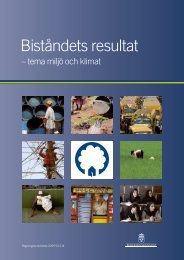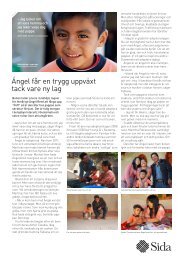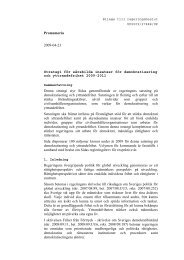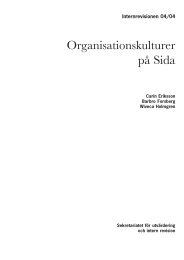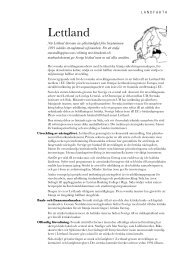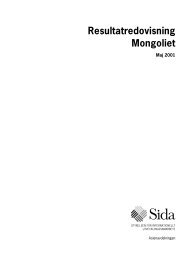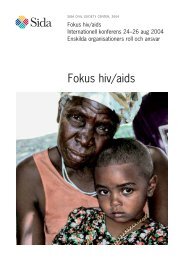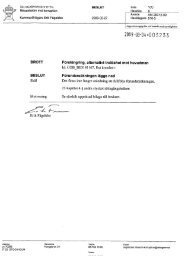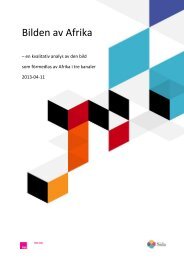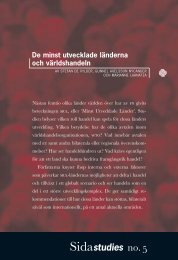Mobilisation of the Poor – a means to Poverty Reduction? - Sida
Mobilisation of the Poor – a means to Poverty Reduction? - Sida
Mobilisation of the Poor – a means to Poverty Reduction? - Sida
You also want an ePaper? Increase the reach of your titles
YUMPU automatically turns print PDFs into web optimized ePapers that Google loves.
2 Evolution <strong>of</strong> <strong>the</strong> Change Agent Programme<br />
This chapter examines <strong>the</strong> social, economic and cultural context from which CAP emerged in 1978<br />
and <strong>the</strong> changes <strong>the</strong> programme underwent during its nearly 23 years <strong>of</strong> development up until<br />
2001. There are two ways <strong>of</strong> interpreting CAP’s changes. One is <strong>to</strong> recognise that <strong>the</strong> original<br />
formula <strong>of</strong> conscientising <strong>the</strong> poor with a view <strong>to</strong> harnessing <strong>the</strong>ir collective energies <strong>to</strong> overcome<br />
<strong>the</strong>ir existing disadvantages in production/exchange relations is <strong>the</strong> essence <strong>of</strong> CAP methodology,<br />
and see any subsequent deviations from this ideal as dilutions or even dis<strong>to</strong>rtions <strong>of</strong> <strong>the</strong> programme.<br />
This is typically <strong>the</strong> view held by some <strong>of</strong> <strong>the</strong> CAP activists and ideologues that were closely<br />
associated with <strong>the</strong> programme during its formative stage (Sisira Amarasinghe, personal<br />
communication) as well as some outside observers (Lindahl et al. 1991). This view certainly has<br />
some validity in that <strong>the</strong> relative emphasis given <strong>to</strong> social mobilisation, <strong>the</strong> key element <strong>of</strong> <strong>the</strong><br />
original CAP methodology, has progressively declined over time. This approach does tend <strong>to</strong> be<br />
ideologically charged and dogmatic, however, in so far as it has fixed and largely unverified views<br />
about <strong>the</strong> nature <strong>of</strong> rural society and possible ways <strong>of</strong> overcoming problems <strong>the</strong>re.<br />
The o<strong>the</strong>r way <strong>of</strong> looking at it, is that <strong>the</strong> changes in CAP were necessary and even creative<br />
adjustments <strong>of</strong> <strong>the</strong> orientation and strategies <strong>of</strong> <strong>the</strong> programme, in line with pragmatic<br />
considerations and responding <strong>to</strong> an array <strong>of</strong> internal and external pressures. From this point <strong>of</strong><br />
view <strong>the</strong> malleability and adaptability <strong>of</strong> <strong>the</strong> CAP methodology may be one <strong>of</strong> its real strengths and<br />
one <strong>of</strong> <strong>the</strong> reasons <strong>the</strong> programme has been so long-lived, despite <strong>the</strong> many changes in direction<br />
and environment. While also being sensitive <strong>to</strong> <strong>the</strong> first approach, in <strong>the</strong> present analysis we are<br />
more inclined <strong>to</strong> take <strong>the</strong> second.<br />
As is already known, between 1978 and 2001 CAP did not evolve according <strong>to</strong> a set plan, but<br />
underwent pr<strong>of</strong>ound but implicit change, largely in response <strong>to</strong> changes in project administration<br />
and dynamic changes in <strong>the</strong> project environment. In is difficult <strong>to</strong> identify clear stages in its<br />
progress up until now, but for <strong>the</strong> purposes <strong>of</strong> our current analysis four stages <strong>of</strong> development can<br />
be identified:<br />
1. Formative stage: 1978<strong>–</strong>84. This is <strong>the</strong> period in which <strong>the</strong> CAP approach was crystallised as a<br />
distinctive and local approach <strong>to</strong> rural development/poverty alleviation.<br />
2. Period <strong>of</strong> uneven growth: 1985<strong>–</strong>89. In this period CAP “drifted” in different directions,<br />
depending on who was steering <strong>the</strong> programme at <strong>the</strong> <strong>to</strong>p (Ratnaweera 1990).<br />
3. Period <strong>of</strong> rapid expansion: 1990<strong>–</strong>94. This period saw a rapid expansion <strong>of</strong> <strong>the</strong> CAP<br />
programme and rapid dissemination <strong>of</strong> <strong>the</strong> social mobilisation process via o<strong>the</strong>r programmes<br />
being implementing by government and non-government agencies.<br />
4. Development <strong>of</strong> Prajashakti Organisations, which evolved from CAP as au<strong>to</strong>nomous agencies:<br />
1995<strong>–</strong>2001. In this period CAP changed from a government-run programme <strong>to</strong> one managed<br />
by federated CAP groups at various levels with RDTRI facilitating <strong>the</strong> process.<br />
We discuss below important developments in <strong>the</strong> programme in each period.<br />
12<br />
MOBILISATION OF THE POOR <strong>–</strong> A MEANS TO POVERTY REDUCTION <strong>–</strong> <strong>Sida</strong> EVALUATION 02/08




